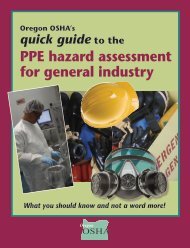Technical Manual - Section 3 (Safety Hazards)
Technical Manual - Section 3 (Safety Hazards)
Technical Manual - Section 3 (Safety Hazards)
Create successful ePaper yourself
Turn your PDF publications into a flip-book with our unique Google optimized e-Paper software.
D. INVESTIGATION GUIDELINES<br />
MANUFACTURED, REMANUFACTURED,<br />
AND REBUILT ROBOTS<br />
All robots should meet minimum design requirements to<br />
insure safe operation by the user. Consideration needs to be<br />
given to a number of factors in designing and building the<br />
robots to industry standards. If older or obsolete robots are<br />
rebuilt or remanufactured, they should be upgraded to<br />
conform to current industry standards.<br />
INSTALLATION<br />
A robot or robot system should be installed by the users in<br />
accordance with the manufacturer's recommendations and in<br />
conformance to acceptable industry standards. Temporary<br />
safeguarding devices and practices should be used to<br />
minimize the hazards associated with the installation of new<br />
equipment. The facilities, peripheral equipment, and<br />
operating conditions which should be considered are:<br />
Every robot should be designed, manufactured,<br />
remanufactured, or rebuilt with safe design and<br />
manufacturing considerations. Improper design and<br />
manufacture can result in hazards to personnel if minimum<br />
industry standards are not conformed to on mechanical<br />
components, controls, methods of operation, and other<br />
required information necessary to insure safe and proper<br />
operating procedures.<br />
@<br />
@<br />
@<br />
@<br />
@<br />
@<br />
@<br />
Installation specifications,<br />
Physical facilities,<br />
Electrical facilities,<br />
Action of peripheral equipment integrated with the<br />
robot,<br />
Identification requirements,<br />
Control and emergency stop requirements, and<br />
Special robot operating procedures or conditions.<br />
To insure that robots are designed, manufactured,<br />
remanufactured, and rebuilt to insure safe operation, it is<br />
recommended that they comply with <strong>Section</strong> 4 of the<br />
ANSI/RIA R15.06-1992 standard for Manufacturing,<br />
Remanufacture, and Rebuild of Robots.<br />
To insure safe operating practices and safe installation of<br />
robots and robot systems, it is recommended that the<br />
minimum requirements of <strong>Section</strong> 5 of the ANSI/RIA<br />
R15.06-1992, Installation of Robots and Robot Systems be<br />
followed. In addition, OSHA's Lockout/ Tagout standards<br />
(29 CFR 1910.147 and 1910.333) must be be followed for<br />
servicing and maintenance.<br />
E. CONTROL AND SAFEGUARDING PERSONNEL<br />
For the planning stage, installation, and subsequent operation<br />
of a robot or robot system, one should consider the following.<br />
RISK ASSESSMENT<br />
At each stage of development of the robot and robot system<br />
a risk assessment should be performed.<br />
There are different system and personnel safeguarding<br />
requirements at each stage. The appropriate level of<br />
safeguarding determined by the risk assessment should be<br />
applied. In addition, the risk assessments for each stage of<br />
development should be documented for future reference.<br />
III:4-10
















